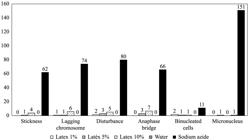Abstract
The latex obtained from Hancornia speciosa Gomes (Mangabeira tree) is widely used in traditional medicine to treat a variety of diseases, including diarrhea, ulcer, gastritis, tuberculosis, acne and warts. In this study, the cytotoxicity and genotoxicity effects of H. speciosa latex on the root meristem cells of Allium cepa were examined. Onion bulbs were exposed to different concentrations of latex and then submitted to microscopic analysis using Giemsa stain. Water was used as a negative control and sodium azide as a positive control. The results showed that, under the testing conditions, the mitotic index (MI) of the onion roots submitted to latex treatment did not differ significantly from the negative control, which suggests that the latex is not cytotoxic. Low incidence of chromosome aberrations in the cells treated with H. speciosa latex was also observed, indicating that the latex does not have genotoxic effect either. The MI and the chromosome aberration frequency responded to the latex concentration, requiring more studies to evaluate the dosage effect on genotoxicity. The results indicate that in tested concentrations H. speciosa latex is probably not harmful to human health and may be potentially used in medicine.
Keywords:
Cerrado; popular medicine; mutagenesis

 Thumbnail
Thumbnail
